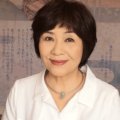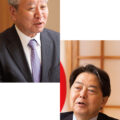Japanese Pianists at the International Chopin Piano Competition — From Uchida Mitsuko and Nakamura Hiroko to Sorita Kyohei and Kobayashi Aimi
Kosaka Haruka, music journalist
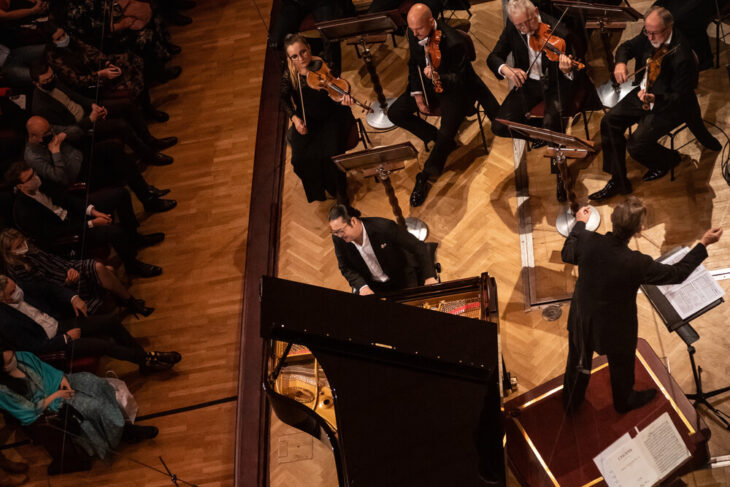
Sorita Kyohei performs at the 18th International Chopin Piano Competition in Warsaw, Poland, October 2021. (Photo from his final-stage performance.)
Photo: Wojciech Grzędziński/Narodowy Instytut Fryderyka Chopina (NIFC)

Kosaka Haruka
Every five years the International Chopin Piano Competition is held in Warsaw, Poland, the country of Chopin’s birth. After being postponed by one year due to the COVID-19 pandemic, the 18th competition was held in October 2021.
Results from the qualifying committee based on documents and video recordings were announced at the beginning of March 2020. But the postponement was decided after that, giving competitors an extra year to prepare. This helped make for an extremely high level, and the pianists of richly individual character competed with Chopin interpretations of great depth.
The competition was won by Bruce Xiaoyu Liu, a Canadian of Chinese heritage. Two Japanese competitors were awarded prizes. In particular, Sorita Kyohei was the first Japanese person to tie for the second prize in 51 years since Uchida Mitsuko in 1970, and received a lot of coverage from the Japanese media.
In this article, I introduce the achievements of Sorita and other Japanese competitors, and also what happened at the most recent competition. But first I’ll start by talking about what kind of event the Chopin Competition is and why it has a special significance for Japanese people.
The Chopin Competition and Japanese people
The first International Chopin Piano Competition was held in January 1927. A professor at the Fryderyk Chopin University of Music, Jerzy Żurawlew, created the competition to put the spotlight back on Poland’s very own composer Chopin and also energize a people exhausted by WW1. That first competition was small in scale with 26 pianists from eight countries, but the competitors included Dmitri Shostakovich who was aiming to become a pianist at the time. He suffered an appendicitis during the competition and didn’t do well.
Since then, as a rule the competition has taken place every five years, with one exception when it was canceled during WWII. It has the longest history of music competitions taking place today. Past winners have gone on to be active at the pinnacle of international classical music, including Maurizio Pollini (1960), Martha Argerich (1965), Krystian Zimerman (1975), Đặng Thái Sơn (1980), and in more recent years, Rafal Blechacz (2005) and Cho Seong-jin (2015).
Japanese pianists took part in the Chopin Competition for the first time in 1937, which was the third competition. They were Kai Miwa and Hara Chieko. Hara in particular was very well received by audience and critics. A Japanese newspaper of the time reported that the audience so protested against her 15th placing that the police were mobilized. Tanaka Kiyoko won 10th place at the fifth competition in 1955. It is said that jury member Arturo Benedetti Michelangeli argued that second-place Vladimir Ashkenazy should be the winner and Tanaka praised more highly. He refused to sign any of the prize diplomas. That Japanese people born before WWII could receive such praise in Chopin’s “home” may have involved more than just pure musical talent. Probably there was an element of surprise that kimono-wearing women from the Far East were performing at a higher level than anyone had imagined.
At the 7th competition, which took place the year after the 1964 Tokyo Olympics, Nakamura Hiroko came fourth. At the time Nakamura had been selected as a soloist for the NHK Symphony Orchestra’s first world tour, and she was already attracting attention as a young woman of genius ability. The media was excited by her brilliant achievements, which increased the Chopin Competition’s profile in Japan even more. In the following 1970 competition Uchida Mitsuko, who I mention above, came second. After receiving her prize, unlike most Japanese competitors, she didn’t return to Japan but moved to London. Perhaps it was the result of this choice, but at present she is the only Japanese pianist recognized as top class on the world stage.
During Japan’s period of high economic growth, people traveling abroad became easier. What’s more, the companies Yamaha and Kawai pushed on with piano manufacture and the setting up of music schools, and playing the piano became very popular. It was from around this time that the number of Japanese competitors and audience members at the Chopin Competition started to increase.
A massively popular craze in Japan
In 1985 the Chopin Competition suddenly became even more popular in Japan. The 11th competition was covered in an NHK documentary, and the winner, Stanislav Bunin of the former USSR, created such a craze that you could call it a social phenomenon.
Three years after the competition, Bunin defected to the former West Germany. In the end, he performed less in Europe, then relocated to Japan where he still lives. In 2021 I had the chance to interview him again and he told me of his strong desire to pass on his techniques and experiences to future generations. He also recalled how, back then, he himself struggled to understand how such a craze could happen in Japan. It was a startling experience, he said.
Amid the craze for piano playing, a mass of Japanese people descended on the 1990 competition. Of 1,070 seats in the hall during the final stage, 260 were occupied by Japanese people. An article on the event describes how many music-loving citizens of Warsaw were unable to get tickets. Perhaps in a sign of their dissatisfaction, applause was sparse even when Japanese pianists performed well. Nevertheless, the Japanese competitors fought bravely, with two receiving prizes: Yokoyama Yukio in 3rd place and Takahashi Takako in 5th.
It was in 2005 that two Japanese pianists next won two prizes, with Sekimoto Shohei and Yamamoto Takashi tying for 4th place. In the subsequent contests of 2010 and 2015 Japanese pianists were unsuccessful and won no prizes.
But in the most recent competition, Japanese pianists again won two prizes. Sorita, who won second place in 2021, said he became aware of the Chopin Competition after seeing a documentary on the 2005 event. “I was captivated by the pianists performing stylishly with an orchestra on the competition stage and thought I wanted to perform there myself one day,” he said. In the recent competition he achieved his dream.
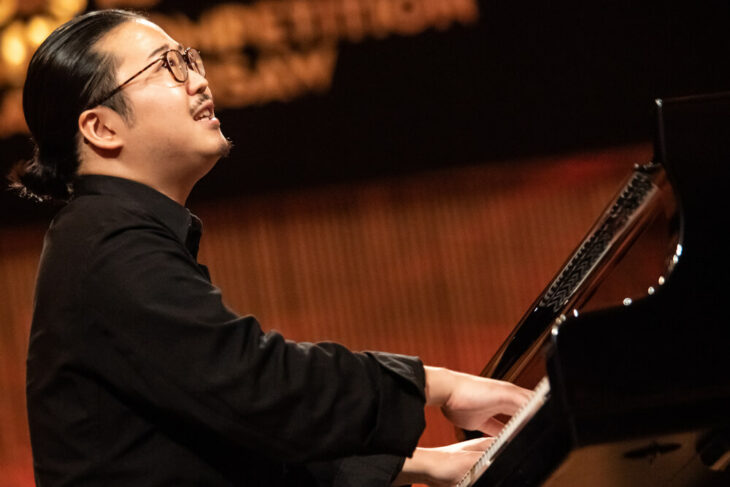
Sorita Kyohei performs at the 18th International Chopin Piano Competition. (Photo from his first-stage performance.)
Photo: Wojciech Grzędziński/NIFC
Most competitors are in their 20s. This generation would have watched and listened to a competition that happened 16 years ago when they were children and starting to learn the piano. Incidentally, in the most recent competition, of the more than 500 pianists who applied to the qualifying committee with documents and video footage, more than 90 were Japanese. It was the second highest number: less than the Chinese applicants (over 100) but more than the Polish (over 60).
A big reason that young people continue to be attracted by the Chopin Competition—not just local pianists in Poland where the competition is shown on live TV each time, but also young Japanese pianists—is that the media covers the activities of these brilliant young people, creating a chain reaction of other young people being inspired by them. Ten or 15 years from now there may be other competitors who describe how they were inspired by Sorita and Kobayashi Aimi’s wins.
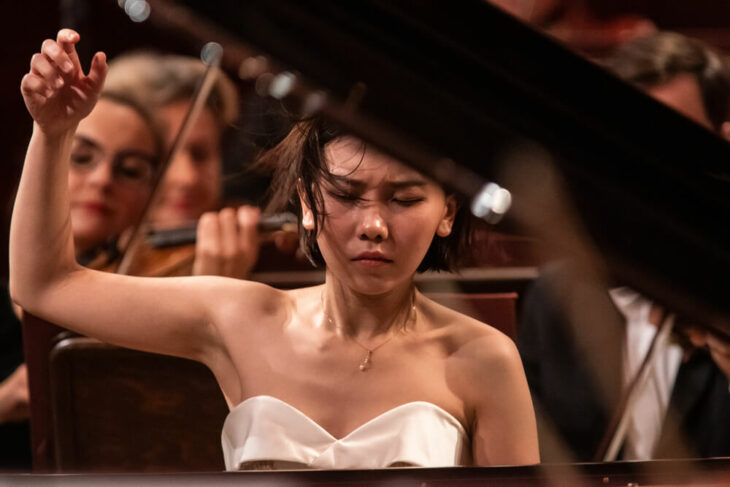
Kobayashi Aimi performs at the 18th International Chopin Piano Competition. (Photo from her final-stage performance.)
Photo: Wojciech Grzędziński/NIFC
What’s more, in recent years it’s not just TV. All the competition’s performances, and even talk sessions with competitors, are broadcast to the whole world on YouTube. There’s a tendency for younger generations to prefer YouTube to TV. They may find heroes other than pianists from their own countries, and the competition’s influence may spread in a different way.
How the competition overcame the COVID-19 pandemic to take place
The recent competition took place during the COVID-19 pandemic with competitors needing vaccination beforehand and a PCR test on registering to take part. Ordinary members of the audience also had to present a certificate of vaccination. Warsaw citizens—who mostly never wore masks outside—were carefully watched by staff to make sure they properly wore masks in the hall. There were no COVID-19 infections reported among competitors or judges.
Despite these moderate restrictions and complications, the competition had the same celebratory atmosphere of a national event as other years. The seats were packed with people and the audience shouted “Bravo!” after performances they liked. There was no “dispersed exit” like in Japan (a measure to reduce congestion around entrances and exits), and people crowded together, chatted, shook hands, and hugged on meeting for the first time in a while. As I came and went through the hall, I felt like I could forget there was a COVID-19 pandemic.
Last spring Poland had a daily peak of over 20,000 infections, but by the summer the situation had finally settled. Prior to the competition, pre-entry measures for those traveling from abroad were toughened. I have heard that the organizers were desperate to have the competition take place and did all they could. I don’t think they wanted pianists with a vast repertoire to quarantine after entering the country.
And so, having overcome repeated postponements and changes in the situation, 87 competition participants and a jury of seventeen judges were welcomed and the Chopin Competition successfully took place.
The Internet broadcasts that started in 2005 are of ever better quality. Online viewing has become the norm during the COVID-19 pandemic and the broadcasts were seen by many people around the world.
Among them, there was one Japanese who was by far the most viewed. Sumino Hayato is a Tokyo University graduate, pianist, and popular YouTuber called “Cateen” with more than 860,000 subscribers. For example, the video of his performance in the preliminary round has over 1.31 million views. By comparison, that is far more than even the actual winner Bruce Xiaoyu Liu’s 270,000 views (figures are all as of 11 November 2021).
In 2018 while a graduate student, Sumino won the Grand Prix at the PTNA (Piano Teachers’ National Association) Piano Competition, a competition held in Japan for classical pianists, and this was the catalyst for him starting his professional musical career. His wide-ranging activities aren’t limited to classical music, and include playing in a band, composition, arrangement, and improvisation. He said that at one time he considered the art form of reproduction that is classical music and “despaired when I thought about how absurd it would be to try and create something when there were already so many famous musical recordings.”
But in 2020, having become known as a YouTuber, he started to think, “How can I contribute to the music world?” That sense of mission was the part of his motivation for attempting the recent competition.
How would a historic classical music competition judge Sumino’s performance? Not just his fans, but many people involved in music and classical musical enthusiasts wanted to know. In the end he missed out on getting to the final, but he did get to the third stage with 23 other pianists, and some of the jury wanted him to go on to the final. In fact, Sumino’s performances have changed a lot over the last half year or so. It seems he has continued to explore ways of producing sound, decided on a personal approach to Chopin, and developed his performances.
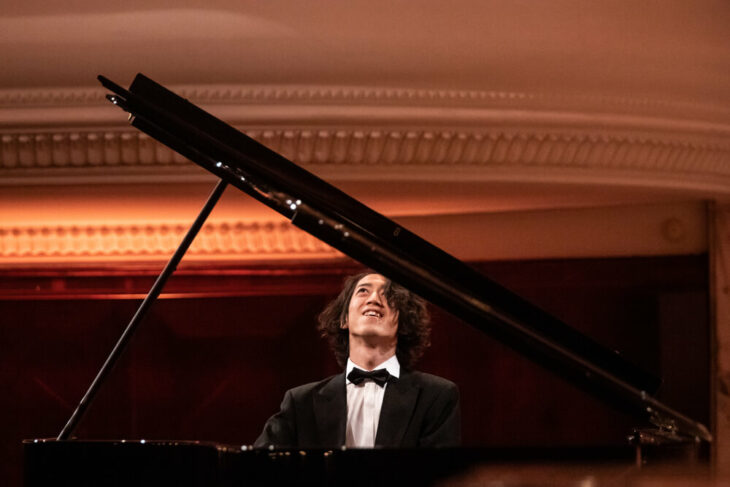
Sumino Hayato performs at the 18th International Chopin Piano Competition. (Photo from his third stage performance)
Photo: Darek Golik/NIFC
Judging criteria for new times
Looking at the winners selected by the jury in the latest competition, first of all I sense that a real diversity of individual character has been acknowledged. There is also a tendency to recognize energetic and bright musicality.
The jury sought not just superb pianists but world-class Chopin playing. The pianist must correctly read and study the sheet music. On the struck stringed instrument that is the piano, the pianist must express the necessary “song” in Chopin’s expression. They must understand the culture and history of Poland, a country constantly ruled by the countries that surrounded it. They must become intimate with the sentiments of Chopin himself, who traveled to a foreign country aged 20 before dying from a disease of the lungs at 39. That’s why, generally, the ideal has been that even when performing a cheerful composition, somewhere there should be a sense of pathos.
But this time music played by the winner Bruce Xiaoyu Liu was sparkling and optimistic. It overflowed with the feel of a live performance where one can’t imagine what will come next—and that was its fascination. In fact, Liu said, “I didn’t think I was suited to performing Chopin.”
“Generally speaking, people think that Chopin was full of sorrow, nostalgia and suffering, and that his music was too. But I have a completely opposite character. Chopin was a human being, and he couldn’t have been constantly sad. I am sure he also had happy times. I don’t know if this is a new approach to Chopin or not, but it’s my personality so I used the expression I believe in most.”
When he came to Japan right after the competition, he said, “I want people to quickly forget that I won the Chopin Competition.” Behind those words was a desire to be recognized as a pianist that tackles a repertoire of other pieces he is good at, not just Chopin, and for people to come and listen to him, not just because he is the competition winner. He came out with this half a month after the competition, showing how he is not overly bound by reverence for the competition, and how his approach is to pursue his own music.
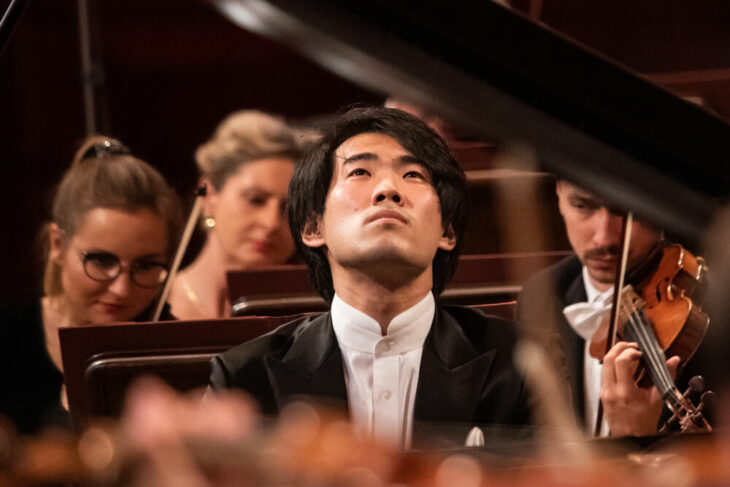
18th International Fryderyk Chopin Piano Competition winner Bruce Xiaoyu Liu performs in the final stage of the competition.
Photo: Wojciech Grzędziński/NIFC
Sorita Kyohei and Kobayashi Aimi’s challenge
Sorita Kyohei, who came second with Alexander Gadjiev of Italy/Slovenia, is a pianist with a powerful and fresh sound, capable of rich emotional expression that can catch the audience’s hearts. Rather than the music of the sickly Chopin himself, his playing may be closer to the image of music played by a healthy and talented disciple or friend whom Chopin loved and admired.
Sorita started to form his plan on deciding to take part in the competition six years beforehand. Four years before the competition, he studied at the Fryderyk Chopin University of Music in Warsaw and studied Chopin under one of the competition jury members Piotr Paleczny. He intentionally put on weight in order to bulk up his body and produce enough sound for the competition hall. He tied up his long hair and was affectionately called “samurai” by the Polish media. When it came to his repertoire too, he carefully considered what to play by consulting special features in old music magazines and records of how jury members had marked past competitions. Thanks to both natural musical ability and these strategies, he successfully achieved a top placing in the competition.
Sorita had already attracted attention for entrepreneurial activities that went beyond just performing, such as creating a record label, and setting up an orchestra and company with associates. As well as simple admiration for the event, a large part of his motivation for attempting the Chopin Competition was that, he said, “in order to bring my orchestra before the world, as its leader I had to be more internationally noticed.”
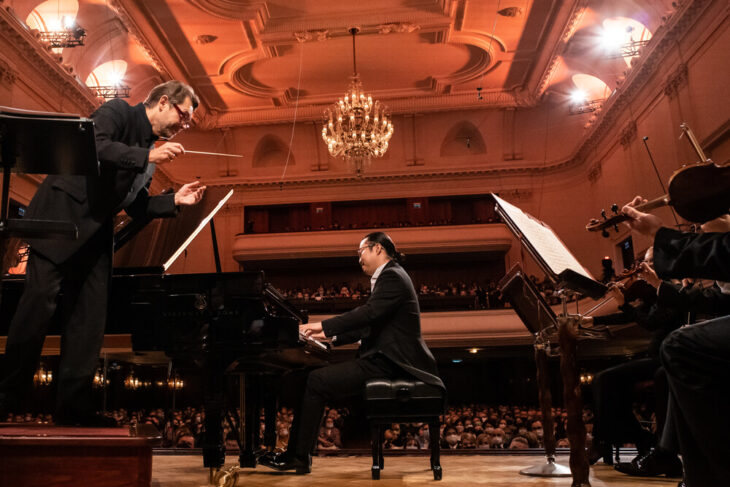
Sorita Kyohei performs at the 18th International Chopin Piano Competition, in which he finished in joint second place. (Photo from his final-stage performance.)
Photo: Wojciech Grzędziński/NIFC
Meanwhile, Kobayashi Aimi, who came in fourth place, was competing for the second time. Although she was a finalist in the previous competition and had the pressure of wanting to do even better, essentially she focused on playing the music just as she wanted. She explained about how she felt when performing Chopin’s Prelude No. 24 (Op. 28), which was greatly praised. “Considering the harsh situation in Poland in those years, I think that any piece—even those with a light feel to them—contained pain, suffering and hope. In my own way, I tried to get a feel for Chopin’s sincere desire to demonstrate his Polish identity.”
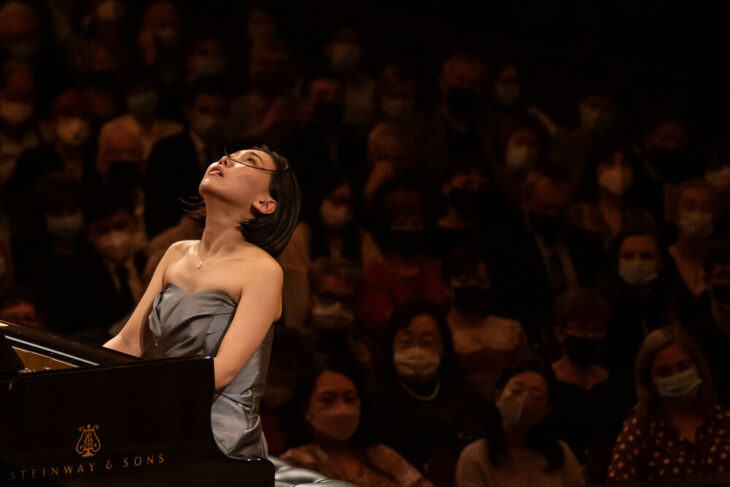
Kobayashi Aimi performs at the 18th International Chopin Piano Competition. (Photo from her third-stage performance.)
Photo: Darek Golik/NIFC
Regarding the future, she said, “Pianists who stir up the audience with showy performances are great, but I am not aiming to be that kind of pianist. I want to be a pianist through whom people just feel the music.”
Due to Kobayashi and other Japanese pianists’ wins, the national character of the Japanese people became a topic of discussion during the recent competition. People within the arts have noted that it is difficult to develop talent in Japanese education, due to a tendency to teach students that they mustn’t stand out, that they have to fit in with those around them. But perhaps finally a change is happening? Jury member Đặng Thái Sơn, who was the teacher of the recent winner Liu, and who has led many Asian students to wins, said this. “In the past, there were ‘Japanese pianist’ performances.” But it’s different now. I felt individuality in each. I think it’s a wonderful thing.”
A Chopin Competition for new times
Diverse individuality was recognized at the recent competition. But the background to that was a truly wide range of appraisal among jury members. One jury member said, “I’ve never experienced a competition where the jury members were so divided.” Perhaps that’s exactly why completely different types of pianists were among the top winners.
Writing as a single, slightly conservative audience member who has felt in my heart somewhere that I wanted artists to offer up their soul to Chopin in this historic competition dedicated to Chopin, I am slightly dazzled and taken aback by the new sensibility of not just Liu, but Sorita and Sumino too.
But these individuals are the kind of musicians that live powerfully through times like these, and supply the music that people want today. The Chopin Competition may also have now entered a new age.
Translated from “Uchida Mitsuko, Nakamura Hiroko kara Sorita Kyohei, Kobayashi Aimi made: Shopan konkuru, Nihonjin pianisuto no yakudo (Japanese Pianists at the International Chopin Piano Competition — From Uchida Mitsuko and Nakamura Hiroko to Sorita Kyohei and Kobayashi Aimi),” Chuokoron, January 2022, pp. 172–179. (Courtesy of Chuo Koron Shinsha) [February 2022]
Keywords
- Kosaka Haruka
- music writer
- Chopin
- International Chopin Piano Competition
- Fryderyk Chopin University of Music
- Poland
- Bruce Xiaoyu Liu
- Sorita Kyohei
- Kobayashi Aimi
- Uchida Mitsuko
- Kai Miwa
- Hara Chieko
- Tanaka Kiyoko
- Nakamura Hiroko
- Yamaha
- Kawai
- Stanislav Bunin
- Yokoyama Yukio
- Takahashi Takako
- Sekimoto Shohei
- Yamamoto Takashi
- Sumino Hayato
- Đặng Thái Sơn
